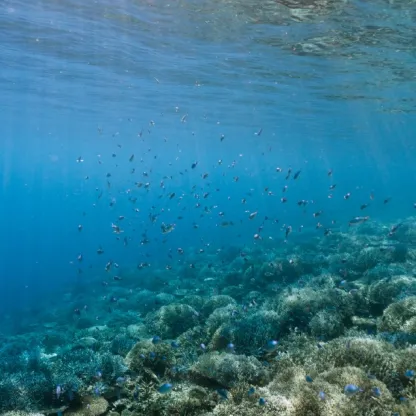A new joint report by leading energy thinktanks finds over 1.7TW of renewable energy projects are stuck in grid queues across Europe—highlighting outdated infrastructure, unclear regulations, and missed climate targets. The report signals growing systemic risks to the energy transition and underscores the urgent need for smarter, faster grid reform.

Sustainability update June 2025
Article last updated 15 August 2025.
European renewable energy connectivity limited by slow grid development
A joint report by energy thinktanks Beyond Fossil Fuels, Ember, E3G and the Institute for Energy Economics and Financial Analysis (IEEFA) found that more than 1.7 Terawatts (TW) of renewable energy projects across Europe were stuck in grid connection queues due to slow infrastructural development, outdated connectivity regulations, and unclear mandates for national energy regulators.
The report indicated that Europe’s grid connections weren’t modernising quickly enough – 1.7TW of queued renewable energy is over three times the level of capacity needed for the region to meet its 2030 emissions and mixed energy targets. Research also found significant regional investment in curtailment, a process where electricity outputs from renewables are deliberately reduced when there’s an excess of supply. In 2024, €7.2 billion was spent on curtailment from just seven European markets. Because European governments, energy regulators and electricity transmission system operators (TSOs) aren’t adequately planning for the storage and delivery of renewable energy sources, the report argued, they’re risking a future of regional energy insecurity and continuing fossil fuel dependency. Recommendations to address these shortcomings included increased government support to unlock public and private finance for grid infrastructure, flexibility and energy storage, and closer cooperation between TSOs and governments to reform regulation pertaining to grid planning and bloc-wide connection and queue ordering processes.
Similar reforms have already begun in the UK where the government is working with energy industry regulator Ofgem and national planning and supply management body the National Energy System Operator (NESO) to clear out so-called “zombie” projects and prioritise viable infrastructural developments. National Grid has promised to more than double its investment in domestic grid infrastructure in the next five years, committing over £30 billion to its “Grid for growth” network expansion programme. This aligns with a core objective of the government’s new Modern Industrial Strategy to enhance and prioritise grid capacity for economically significant projects. Elsewhere, the UK and Norway launched a new Green Industrial Partnership agreeing plans for cooperative investment and innovation in offshore wind, hydrogen, carbon capture and storage (CCS), and green infrastructure. Plans to expand North Sea wind infrastructure could potentially deliver 120GW of additional offshore capacity by 2030, enough to power 120 million homes.
UN Ocean Conference secures key marine protection pledges but highlights significant financing gap
The five-day UN Ocean Conference (UNOC3) co-hosted by France and Costa Rica saw 15,000 attendees and more than 60 heads of state convene in Nice for a third round of talks to agree terms for multilateral commitments to protect and preserve the world’s oceans. Over 3 billion people depend directly on oceans for their livelihoods, but excessive exploitation, insufficient conservation and rising temperatures have contributed to a significant decline in marine health and resource capacity.
More than 190 countries adopted the Kunming-Montreal Global Biodiversity Framework (GBF) in 2022, requiring the effective conservation or restoration of at least 30% of the world’s terrestrial and aquatic areas by 2030. However, a report supported by the Bloomberg Ocean Fund and published in October 2024 determined that only 2.8% of the world’s oceans were “effectively” protected, while just 8% had been designated as Marine Protected Areas (MPAs).
In Nice, 19 more countries ratified the UN High Seas Treaty – the first to protect and conserve global marine biodiversity – bringing the total number of ratifications to 50. While the treaty requires a minimum of 60 ratifications to come into force, several countries signalled their intention to submit ratification instruments in the coming months. More countries also backed a moratorium or precautionary pause on global deep-sea mining pending more detailed research on its environmental impacts. Several governments announced the creation or expansion of MPAs. French Polynesia pledged to protect its entire exclusive economic zone, creating the world’s largest MPA spanning 5 million square kilometres. Spain announced five new MPAs equivalent to 25% of their marine territory, while Germany pledged €100 million to clear legacy munitions from its North Sea and Baltic seabeds.
Among other financing commitments, public development banks established a new €3 billion financing target to tackle ocean plastic pollution under the Clean Oceans Initiative. The European Commission also pledged €1 billion to support ocean conservation and sustainable fishing. Prior to UNOC3, however, NGOs and financiers from The Ocean Protection Deficit identified a $14.6 billion shortfall in annual funding for ocean safeguarding to 2030. Despite the ocean’s central role in global economics, food security and climate regulation, UN Sustainable Development Goal 14 – Life below water – remains one of the least funded.
Water security: investments in nature-based solutions double in a decade
A new report co-written by The Nature Conservancy and Forest Trends found that global annual investments in nature-based solutions for water security more than doubled from $22.4 billion to $49.1 billion between 2013 and 2023. Total investments in watershed conservation in 2023 across more than 880 initiatives were equivalent to a third of all financial flows into global biodiversity conservation. China, the US and the EU accounted for 94% of total investments during the study period, though Africa experienced the fastest growth in investment outlay. While 97% of funding was provided by national governments, the report identified a growing trend in private sector contributions driven largely by regulatory developments. Investments by direct beneficiaries of water system services such as companies, utilities and cities increased to almost $2 billion by 2023.
Among key water-related objectives, investments focused primarily on flood risk mitigation, improving water quality, and securing clean water supplies. Forests and riverways were the most supported ecosystems while region-specific investments targeted improvements in wetlands, grasslands and shrublands. The increasing scale of investment points to a growing appreciation of nature’s vital role in regulating water systems. Nature-based solutions improve water filtration, reduce soil erosion and flooding, and recharge groundwater supplies. Natural systems also contribute to landslide, fire and drought risk mitigation.
The report coincided with a statement released by the Environment Agency that without urgent action to futureproof resources, England could face a daily 5 billion litre shortfall in public water supplies by 2055 – an additional 1 billion litre daily deficit is forecast for the wider UK economy. The Agency’s investment recommendations include increased leakage mitigation, new desalination infrastructure, and the wider use of smart meters to regulate water use and help reduce waste.
International Energy Agency (IEA) report highlights significant rise in global clean energy investments
Despite continuing economic and geopolitical uncertainty, the IEA’s 10th annual World Energy Investment report forecast that global energy investments in 2025 were expected to rise to a record $3.3 trillion. The bulk of these investment inflows – around $2.2 trillion – will be directed towards clean energy technologies and efficiency programmes, while global fossil fuel investment will peak at around $1.1 trillion. The report attributed the widening investment gap between traditional and alternative energy sources to multiple drivers including global energy security, policy support, and the increasing cost-competitiveness of renewables.
The IEA highlighted China’s recent drive to reduce reliance on fossil fuel imports and accelerate global leadership on clean energy technologies. Europe’s increased spending on renewables and efficiency programmes as a response to the war in Ukraine and US efforts to challenge China’s position in clean energy supply chains were also cited as key drivers for increased clean energy investments. Led by solar PV, global investment in low-emissions power generation almost doubled in the last five years with spending forecast to reach $450 billion in 2025 – the largest single energy source investment in the IEA’s annual calculation. Growing interest in advanced nuclear technologies was reflected in a 50% increase in plant development and refurbishment spending over the last five years.
One Big Beautiful Bill?
Early in July, the ‘One Big Beautiful Bill Act’ (OBBB) was passed by the US House of Representatives. A flagship part of Donald Trump’s policy agenda, and passed as a budget reconciliation package to sidestep any attempts to filibuster the bill, the final Act was passed by a narrow margin after months of intensive negotiations. OBBB is undoubtably a headwind for progress on sustainability and decarbonisation in the US, with significant roll backs in the Inflation Reduction Act, funding for wind, solar, and EV tax credits, and a reallocation of resources toward fossil fuel expansion and immigration enforcement. Early modelling by research groups estimated that OBBB, as passed, could lead to carbon emissions in the US being 8-12% higher in the next decade than if the Inflation Reduction Act remained in place.
Despite these challenges, OBBB retained key clean energy tax credits and support for technologies like carbon capture, nuclear, and grid infrastructure and it was seen as positive for investor sentiment given the worst-case scenario was avoided. We continue to carefully assess the risks and opportunities from this reshaped policy landscape, be they financial, social or environmental in nature.





